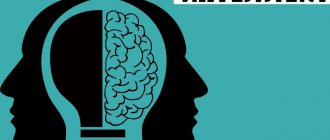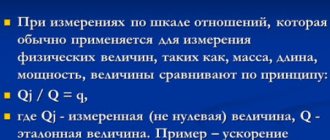Interpretation of the term in question
Modality is the form of manifestation of the stimulus in the existing human sensory system (auditory, visual, tactile). Translated from Latin, this term means “way”.
The leading modality is the individual's preference for the “sensory food” through which the person is most aware of what is happening.
In contrast to the spatial, intensity and temporal characteristics of sensations, the characteristics under consideration reflect certain properties of reality through their specifically encoded form. For example, the wavelength of light is perceived as light, and the frequency of sound waves is reflected as tone.
Modality in psychology is a general name for both the channels of primary perception and the channels of internal processing of information material.
How to measure sensitivity
Professionals are particularly sensitive to sounds, smells and colors. Only a trained musician can hear falsehood in the performance of a piece of music. An artist can distinguish color shades better than an amateur. Can these individual differences be measured?
Yes, and psychological research is aimed at measuring two types of sensitivity: absolute and difference.
Here is the easiest way to observe how people differ in hearing acuity. Sit them next to each other and ask them to close their eyes. Then slowly approach them with a ticking clock or metronome. The one who hears the sound earlier has higher absolute hearing sensitivity. And whoever first feels that the sound has become louder has a higher difference hearing sensitivity. A pattern derived by psychophysiologist S. Stevenson indicates that the weaker the signal that a person is able to perceive, the higher his sensitivity to this type of signal. And, conversely, with low sensitivity a person needs a signal of greater strength. This is why trained professionals differentiate sounds, smells and tastes so subtly - they are able to capture the subtlest shades and feel the slightest difference between signals of different strengths.
Types of modality
It is a well-known fact that the nervous system of an individual person is individual and unique. The same is true with the so-called information food for her.
The following types of modality are distinguished:
- Visual – visual (pictures, color, visual images and light).
- Auditory – auditory (sounds, music, auditory images and intonations).
- Kinesthetic – tactile (touch, muscle and skin feeling, internal sensations).
- Logical - semantic, abstract, discrete (terms, reasoning, generalized concepts).
This perception channel is additional. Its peculiarity is the use of information obtained not from primary sensations. The logical view of the modality acts as a secondary sensory channel. But a person can process information received through primary channels in such a way that it loses all connections with them (semantic channel). It reflects the process of understanding information using abstract knowledge.
According to the Russian scientist I.P. Pavlova, logical modality is the second signaling system. Scientists most often strive to use this channel for communication; they try to activate it among schoolchildren.
For communication, the first three above-mentioned channels are of greatest importance. Almost every person has one channel of perception of existing information that prevails over others.
In this regard, there is a need to satisfy sensory hunger, but not with any information, but exclusively with that which is required by the leading modality of the individual.
For greater clarity, it is worth giving a clear example: to solve a given problem, one person will analyze the possible answers by sketching on paper, and another will speak them out loud, and a third will connect the objects at hand.
Is it possible to develop your sensitivity?
Yes. Actually, this is what happens among professionals who train their ear for music, or sense of smell, or color discrimination. Sensitivity can be trained. A trained person is able to distinguish up to 40 shades of black. This is what distinguished and proud fabric dyers.
And a person’s reward for the subtlety of sensations is the different sides of the world that open up to him with new facets. By developing the ability to distinguish shades of colors or musical phrases of complex shapes, a person develops his artistic abilities. Having learned to differentiate taste sensations, he becomes able to enjoy the subtlest shades of taste of coffee, or cognac, or wine, or a culinary masterpiece.
On the contrary, the absence of such taste sensitivity is replaced by a habit of obvious taste. And then for a person, the most delicious thing for the rest of his life remains only what he is accustomed to.
Kinesthetic channel of perception
This is a modality of sensations, that is, bodily perception, which is designated as “somatic sensations.” They, in turn, are divided into internal (pain, relaxation and tension, muscle feeling, sensation of movement and posture, work of internal organs) and external (temperature (cold and heat), vibration, pressure).
Kinesthetic channels of perception are closely intertwined with emotions, which reflect the same internal sensations, and are verbally described in the same way as they are. For example, “light at heart.”
There is also an osmic modality of sensations (olfactory - taste and smell). Most often, this channel of perception is combined with the kinesthetic one. However, smell and taste belong to completely different perception systems, but still a person analyzes them simultaneously, and in this regard they are grouped together. An example would be the expressions: “delicate taste”, “sweet smell”, etc.
Without smell, the entire flavor palette is significantly lost. In practice, this can be confirmed by the common phenomenon when a person with an impaired sense of smell (nasal congestion) takes food that seems tasteless and insipid to him, although the organ responsible for taste functions normally.
List of submodalities
The following is a list of submodalities and possible questions that can identify them.
Visual
| Position | Where is the picture? Where is this image located in space? Show the location of the image with your hands. Is the picture left or right of center? Is this picture slanted? |
| Distance | How close (far) is the image from you? Try to show the distance to the image with your hand. |
| Color – b/w | Is it color or black and white? Are there colors in the picture? |
| Colors | What colors are in this image? Are the colors vibrant, bright or faded? |
| Brightness | Is this picture rather bright or dark? In this context, is it brighter or darker than usual? |
| Focus | Is this image sharp or is it blurry? Is the picture in focus or blurry? |
| Detail | How detailed is this image? Are there many or few details? Do you only see general outlines or can you discern details? |
| Background | Is there a background? |
| Form | What shape is this picture - round, square, rectangular? |
| Association - dissociation | Do you see yourself from the outside or look at everything with your own eyes? If dissociation: Do you see yourself on the right, left or above? Can you see your face or your back? |
| Panoramic | Are you inside the image? Does the picture surround you or do you see it from the outside? |
| Border | Does this picture have borders or are the edges blurry? Does the border have a color? How wide is this limit? |
| Movement | Is this a movie or a slide (photography)? Is there movement in this image or is it static? How fast is this movement? |
| Proportions | Are the sizes of people and things in this picture normal, or is there something larger/smaller? |
| Dimension | Is it flat or voluminous? |
Auditory
| Position | Do you hear it from inside or outside? Is the sound source located inside you? Where is this sound coming from? |
| Height | What is the pitch of the sound? Is the sound more high-pitched or low-pitched? |
| Volume | What's the volume of this? Is the sound loud or quiet? |
| Mono/stereo | Surround sound? Do you hear it from one side, from both sides, or does the sound surround you? |
| Monotone | Is it a monotonous sound or a melody? |
| Pace | Is it fast or slow? |
| Rhythm | Does this sound have rhythm? If there is, try to show it by moving your palm. |
| Duration | Is it continuous or intermittent? |
Kinesthetic
| Quality | How would you describe the body sensations: trembling, tingling, warmth, cold, vibration, relaxation, tension... |
| Intensity | How strong is this feeling? |
| Position | Where is this feeling located? Show with your hand the location of this. |
| Movement | Is this sensation moving or static? Is this movement continuous or does it occur in waves? |
| Direction | Where does this movement start from? What is the direction of its movement? How does it come from its place of origin to the place where you are most aware of it? |
| Speed | Does the sensation move quickly or slowly? Are there jerks or is it a smooth movement? |
| Size | Is this sensation of a stable size or expanding (contracting)? |
Modality of judgments
This is, to a certain extent, additional information expressed in the corresponding judgment regarding its logical or actual status, as well as evaluative, regulatory, temporal and other characteristics.
The modality of judgments is represented by such important and most common varieties as:
- alethic;
- epistemic;
- deontic;
- axiological.
“I recognize a sweetheart by his gait”
Only a pronounced kinesthetic person could say that!
An internally oriented kinesthetic person most often even sits differently than others: with his arms and legs crossed, his head down, as if he is constantly listening to himself and his state.
For an externally oriented kinesthetic learner, for example, it is important:
- How they touch him, and what he himself touches;
- How tense are his muscles?
- What does his intuition tell him;
- Whether he is sitting, standing or walking.
So, you are a kinesthetic learner if most of the 10 conditions listed below are true for you:
A
To make an important decision, you
- often turn to your intuition;
- must make sure that nothing disturbs or worries you in the decision made;
- should experience a feeling of satisfaction from the solution found;
- Having compared the options, you clearly feel the attractiveness of one of them for you;
- must trust the one who offers this solution.
B. You will make your choice if
- you just feel like you like the choice you made;
- you feel trust;
- there are no vague feelings disturbing you that something is going wrong;
- you feel the tension subsiding from finding the right solution;
- if there is a feeling of joy from a job well done.
There are many different answers to the question of how to determine the modality of perception, and there are enough diagnostic techniques, tests and methods to figure it out. We showed only one of many options.
But it is equally important, having determined your type of perception, not to stop there, but to try to begin to develop other sensory abilities. Special simulators are useful for this, such as exercises for the development of figurative memory or figurative perception
Types of alethic modality
They are represented by the following restrictions:
- Problematic (judgment regarding the possibility of an event occurring). Now the above example takes the following form: In Russia, reforms can be carried out in relation to the Armed Forces. Assertoric (judgments about a really existing fact). For example: In Russia, the Armed Forces are currently undergoing reform. As can be seen from the example, there is no expression of modality, but only the immediate fact of what is happening is stated.
- Apodictic (judgments regarding the necessity of an event). Example: In Russia it is necessary to carry out a number of reforms in relation to the Armed Forces.
Exercise “How will I know”
The point of this exercise is not about how you calculate (for example, “mine is not mine”, this is a process of evaluation), but how you know about it. That is, after you have calculated, you somehow find out “mine is not mine.” Every time you look in the mirror, you don’t carry out complex “I am not me” calculations. You already know about this. How do you find out about this? Compare submodal differences:
| I | Not me |
| the image is brighter, clearer, more voluminous | image dimmer more blurry flat |
Visual channel
Me or not me
Imagine yourself in the middle of a group of people. How do the submodalities of your image differ from the submodalities of the people around you?
Whether you like the food or not.
Imagine that there are several dishes on the table that you like, and several that you would not eat. What is the difference between the submodalities of the image of “tasty” and “tasteless” food?
Mine is not mine.
Imagine that there are a dozen completely identical pens on the table. But one of them is yours. How does her performance differ from others?
Important - not important. Imagine two things (situations, people), one of which is important to you, the other is completely unimportant
What is the difference between the submodalities of the first and second image?
Imagine two things (situations, people), one of which is important to you, the other is completely unimportant. How do the submodalities of the first and second images differ?
Auditory channel
My voice and someone else's
Likewise. How do the submodalities of my voice (for example, tape recording) differ from the voice of another person.
Definition of epistemic modality
It characterizes the degree of truthfulness of knowledge. Epistemic modality is information expressed through a judgment regarding the grounds for its acceptance and the degree of validity. That is, in the process of exchanging information during communication between people, a clear awareness of the reasons for accepting or not accepting assessments, opinions, factual data, etc. expressed through statements is assumed.
The decision to accept a statement is influenced by many objective and subjective, external and internal factors, the most important of which are logical (the basis is the opinions of judgments that express faith) and extra-logical (judgments that are logically justified and express knowledge). The manifestation of this modality of perception occurs through the words: “unprovable”, “refuted”, “proven”, etc.
How can we use submodalities
By controlling submodalities, we can control assessment. That is, change the assessment of a situation from unpleasant to pleasant (or vice versa), remove obsessions (for example, overeating and smoking - obsessions), turn confusion into understanding, create and destroy beliefs and many, many more interesting things
Our attention is also controlled using submodalities. This is his “command language”
Knowing this language, you can do whatever you want with attention. For example, we focus on a subject, usually making it sharper and brighter, and turning everything else into a gray “background”. By changing the submodalities of perception of the current situation, you can do a lot of very funny things: control your state, remove unnecessary things (for example, not hear disturbing noise), notice what others miss, tune in only to what is happening outside, or completely immerse yourself. In addition, submodalities are a “command language” for managing our emotions and states. Knowing this language, you can evoke the desired state in yourself, create a new one, or reduce the intensity of an unpleasant emotion. You can control your creative state, get drunk without alcohol or a hangover, or stay completely awake for several days.
Linguistic scope of application of this concept
Modality in language (English) is a certain characteristic that denotes probability, necessity, possibility.
There are five main modal verbs, four of which have the past tense form (indicated below through the corresponding “/” sign).
So, it’s worth listing them:
- can/could;
- may/might;
- shall/should;
- will/would;
- must / absent.
However, this concept is expressed not only through modal verbs, but also through modal adverbs, such as:
- likely (most likely);
- surely (probably);
- possibly (perhaps), etc.
Why adaptation is needed
The human brain is plastic, and if the sense organs are affected by a signal for a sufficiently long time, then the sensation generated by this signal gradually dulls and weakens. The adaptation mechanism is triggered.
You enter a dark room and at first you see nothing. Gradually, the eyes adapt to the darkness, and objects acquire distinct outlines. When you return to a well-lit room, you will again need time to adapt, this time to the light.
Now imagine that you left your home for a while and then returned. You enter a familiar room and the first impression is the extraordinary sharpness of all the objects located here. When you left, you didn’t experience this, but now you look back and are surprised: everything seems to be the same, but different. But after a while everything returns to normal again. This again triggered the adaptation mechanism, thanks to which the sensations seem to dull, losing their sharpness and brightness.
Maybe that’s why psychologists suggest that spouses who have ceased to feel a sense of novelty towards each other should separate for a few days, so that later, when they meet, they look at each other in a new way? To neutralize the adaptation, due to which the excitement from the aroma, image and touch of a loved one has gone. Somehow, imperceptibly, he or she has become a familiar element of the home.
Although adaptation does not serve the best purpose in the last example, it is nevertheless a very important biological mechanism. Man lives in a rapidly changing world and operates within a turbulent environment. Adaptation performs, first of all, an orienting function, helping to discard the usual familiar signals and focus on new ones. Therefore, while listening to music in a concert hall, you may well be distracted by your thoughts or the whisper of a neighbor, especially if the music does not captivate you.
Another adaptation function - protective - helps to adapt to strong stimuli and, ultimately, stop noticing them. This adaptive mechanism reduces our energy costs.
The types of sensations differ in the speed of adaptation. Olfactory and tactile receptors adapt faster than with visual and auditory sensations. Those who wear glasses and have the habit of sliding them onto their forehead know how easy it is to forget about them - adaptation to the tactile stimulus quickly occurs.
Classification of sensations
Types of sensations are divided into 3 main types:
But at different times, different scientists proposed their own classifications of sensations.
Wundt classification
Sherrington classification
Sherrington, based on the localization (location) of receptors, identified three main classes of sensations:
Head classification
G. Head believed that the correct division of sensations should occur according to their origin:
Classification by contact with irritant
Based on contact with the stimulus, sensations are divided into two types:
These sensations are intermodal and, therefore, can be considered multisensory.











